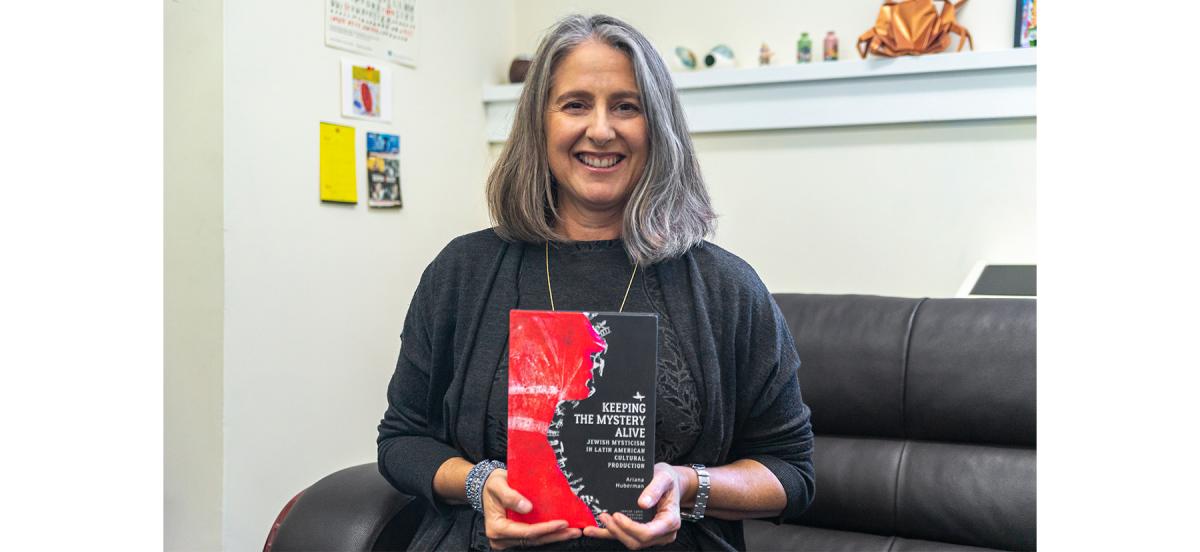A Conversation with Ariana Huberman

Professor of Spanish Ariana Huberman with her new book, "Keeping the Mystery Alive: Jewish Mysticism in Latin American Cultural Production." Photo by Patrick Montero.
Details
The associate professor of Spanish talks about her new book, which investigates the underlying themes of Jewish mysticism in modern Latin American art.
Associate Professor of Spanish, Faculty Director of the Center for Peace and Global Citizenship (CPGC), and Coordinator of Latin American and Iberian Studies Ariana Huberman loves to investigate the unexplored intersections of Latin American and Jewish culture in her research. In her new book, Keeping the Mystery Alive: Jewish Mysticism in Latin American Cultural Production, she delves into the different ways the Kabbalah, or the Jewish mystical tradition, is expressed in modern Latin American art through literary and cultural analysis.
As someone who grew up in Argentina, did personal experience inform or inspire this work?
Ariana Huberman: Yes, in several ways. Growing up Jewish in a majority Catholic country made me curious about aspects of religious traditions that were beyond my grasp. Also, I fell in love with literature at a young age because of magical realism, a body of literature that feels very real when you grow up in Latin America. It’s possible to draw a connection between accepting what we don’t understand as part of reality and the Kabbalistic tradition. They both “keep the mystery alive” in the sense that they are interpretative lenses, although the latter is a much older and sophisticated system of interpretation.
Your book’s title begins with “Keeping the Mystery Alive.” What exactly is the mystery?
AH: The mystery is the inquiry, the curiosity to learn more. The books, art pieces, and films I discuss in this book don’t seek exact answers. They promote the desire to know more, to understand better, to keep asking questions. They are infused with the kabbalistic themes and hermeneutics that they recreate in their works.
In particular, Argentine writer Jorge Luis Borges appears to be a very important figure in your research. Why is that?
AH: Borges is one of the most salient figures in Latin American literature, and before my book, he was the only author that received serious academic attention for his representations of Kabbalah. In the introduction, I discuss the importance of his literature and the critical attention he received for his kabbalistic treatment of texts as a starting point of my research. But my book focuses on other authors and artists who have found inspiration in Kabbalah and Hasidism: Alejandro Jodorowsky, Mario Satz, Angelina Muñiz Huberman, Isaac Goldemberg, Xul Solar and Mirta Kupferminc. One of the most interesting things about this genealogy is that it doesn’t actually start with Borges. All of them, including Borges, learned about Jewish Mysticism from Gershom Scholem, the German-Israeli scholar who founded the field of Jewish Studies.
What is the most surprising thing you learned as you worked on this book?
AH: How much I loved writing about art. I honestly had no idea. I always loved art, but not from an intellectual perspective. Thinking about art in relation to literature was eye-opening to me.
Let’s say someone was interested in learning more about Jewish mysticism in Latin American culture. In addition to reading your book, what piece of art would you recommend they begin with?
AH: I think that Xul Solar’s and Mirta Kupferminc’s art are both great ways to learn more about this subject. For those interested in unbounded surrealist aesthetics of the ‘60s and ‘70s, they may want to watch Alejandro Jodorowsky’s films.



